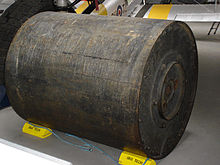Roll bomb

The roll bomb (or rotation bomb , also Dr. Wallis Dambuster , actually "jumping bomb", from the original " bouncing bomb ") was used in particular in the Second World War to destroy German dams . The weapon was designed by Barnes Wallis with the participation of William Glanville .
functionality
In order to bypass and destroy the defense systems at the dams , in particular the torpedo protection nets set up in the water in front of the dam , the roll bombs specially designed for this purpose were used: After these aerial bombs from the extremely deep and fast (at up to 385 km / h ) over the reservoirs in the direction of flying dam bomber type Lancaster had been dropped, they reached the water surface with a previously conferred them backspin (rotational speed: 500 revolutions per minute). As a result, they ricocheted off the surface of the water several times on their way towards the dam wall - following the same physical principles as when jumping stones - and thus overcame the torpedo defense nets in the upper water. After they had reached the dam wall at a low residual speed, they slowly sank down in the water and detonated with a pressure fuse at a depth of about ten meters, so that the walls were destroyed.
Since the Lancasters could not measure the altitude above water, they were equipped with two headlights mounted on the underside at a certain distance and angle to each other. When the circles of light emerging on the surface of the water touched each other and together formed an "8", they indicated the correct altitude for a drop from a height of 18 m. The light figure was continuously observed by the navigator, who reported corrections to the pilot.
The - upper water side - target horizontal distance to Möhnetalsperre was determined by a hand-held horizontal angle-sight with Okularloch and two marking pens. If their horizontal distance coincided with that of the two towers of the dam when looking through them, the distance for dropping the bomb was appropriate.
Operation Chastise

![]() Map with all coordinates of the section Operation Chastise : OSM
Map with all coordinates of the section Operation Chastise : OSM
Under the name Operation Chastise (English "chastisement") the No. 617 Squadron of the Royal Air Force on the clear, moonlit night of May 16-17, 1943, the only roll-bomb attack of the Second World War on the Eder- ( 51 ° 11 ′ 0 ″ N, 9 ° 3 ′ 30 ″ E ) , the Möhne ( 51 ° 29 ′ 23 ″ N, 8 ° 3 ′ 32 ″ E ) and the Sorpe Dam ( 51 ° 21 ′ 4 ″ N, 7 ° 58 ′ 8 ″ E ) through. While the dams of the Eder and Möhne dams were destroyed, the Sorpedamm remained intact despite at least one roll bomb detonated at the target.
Other models
The SB 800 RS "KURT" roll bomb was then developed on the German side.
literature
- Helmuth Euler : When Germany's dams broke. The truth about the bombing of the Möhne-Eder-Sorpe dams in 1943. Motorbuch, Stuttgart 1975, ISBN 3-87943-367-4 .
Web links
- Bouncing Bombs - History, pictures and videos - English, contains several videos of test drops (Format: WMV )
Individual evidence
- ^ Secret Möhnetalsperre - WDR documentary youtube.com, 19: 00-20: 40/43: 47

